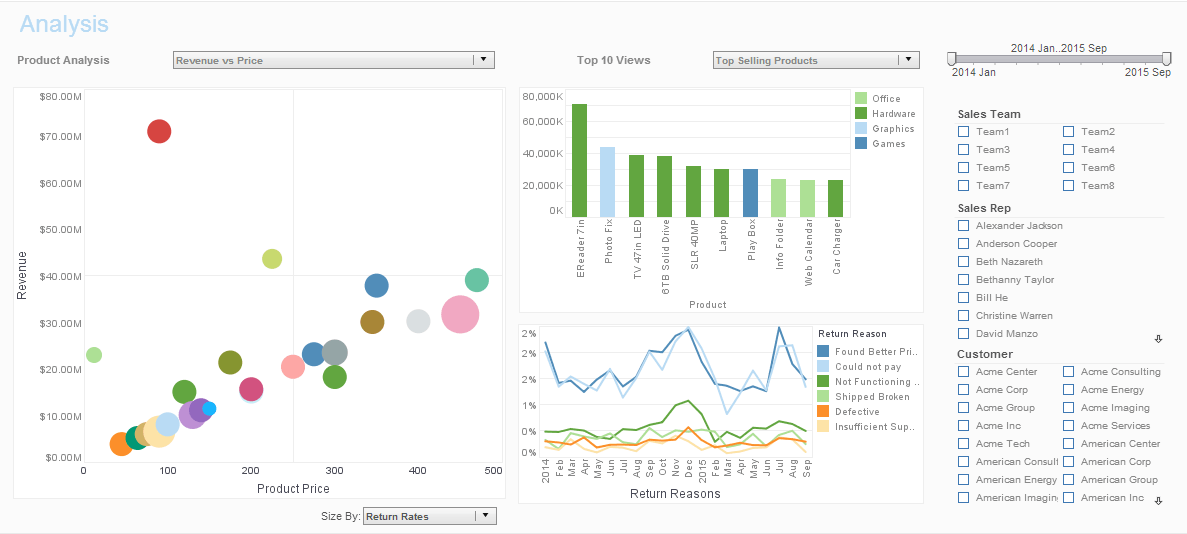InetSoft Products for Making Charts and Graphs
Check out InetSoft's free and commercial tools for charts and graphs. Click the Start Free button, register with any organizational (business, university, or organization) email address. There is no credit card required. Use the 100% web app with no desktop install. Collaborate online in real time.
Use data sources such as uploaded Excel or CSV files or connect to live Google sheets, plus more Google apps, Facebook, databases and many other online data sources. Publicly share dashboards, if you wish, via URL link. Privately share dashboards and analyses within your organization (same email domain). All advanced data visualization types and interactive controls are available.
 |
View a 2-minute demonstration of InetSoft's easy, agile, and robust BI software. |
LinearScale
The LinearScale object contains a linear scale, i.e., a scale that linearly maps numerical values to physical attributes. To create a LinearScale object, call the LinearScale constructor.
var qscale = new LinearScale('Last Year','This Year');
You can pass the names of the fields (e.g., 'Last Year', 'This Year') for which the scale should be generated to the constructor, or specify these later using the inherited Scale.setFields(field) property.
Example (Report or Viewsheet)
importPackage(inetsoft.graph)
importPackage(inetsoft.graph.data)
importPackage(inetsoft.graph.scale)
importPackage(inetsoft.graph.aesthetic)
importPackage(inetsoft.graph.element)
importPackage(inetsoft.graph.coord)
var arr = [["State","Quantity"], ["NJ",200], ["NY",300]];
dataset = new DefaultDataSet(arr);
graph = new EGraph();
var qscale = new LinearScale();
qscale.setFields(["Quantity"]);
var elem = new IntervalElement("State", "Quantity")
graph.setScale("Quantity", qscale);
graph.addElement(elem);
LinearScale.setIncrement(value)
Specifies the interval between values on the scale. When the scale is applied to an axis, this is the interval between values displayed on the axis.
Parameter
value Number specifying interval between values
Example (Report or Viewsheet)
importPackage(inetsoft.graph)
importPackage(inetsoft.graph.data)
importPackage(inetsoft.graph.scale)
importPackage(inetsoft.graph.aesthetic)
importPackage(inetsoft.graph.element)
importPackage(inetsoft.graph.coord)
var arr = [["State", "Quantity"], ["NJ",200], ["NY",300]];
dataset = new DefaultDataSet(arr);
graph = new EGraph();
var qscale = new LinearScale("Quantity");
var elem = new IntervalElement("State", "Quantity")
qscale.setIncrement(15);
graph.setScale("Quantity", qscale);
graph.addElement(elem);
LinearScale.setMax(value)
Specifies the maximum value of the scale.
Parameter
value Number specifying the maximum scale valueExample (Report or Viewsheet)
importPackage(inetsoft.graph)
importPackage(inetsoft.graph.data)
importPackage(inetsoft.graph.scale)
importPackage(inetsoft.graph.aesthetic)
importPackage(inetsoft.graph.element)
importPackage(inetsoft.graph.coord)
var arr = [["State", "Quantity"], ["NJ",200], ["NY",300]];
dataset = new DefaultDataSet(arr);
graph = new EGraph();
var qscale = new LinearScale("Quantity");
var elem = new IntervalElement("State", "Quantity")
qscale.setMin(150);
qscale.setMax(450);
graph.setScale("Quantity", qscale);
graph.addElement(elem);
LinearScale.setMin(value)
Specifies the minimum value of the scale.
Parameter
value Number specifying the minimum scale value
Example (Report or Viewsheet)
importPackage(inetsoft.graph)
importPackage(inetsoft.graph.data)
importPackage(inetsoft.graph.scale)
importPackage(inetsoft.graph.aesthetic)
importPackage(inetsoft.graph.element)
importPackage(inetsoft.graph.coord)
var arr = [["State", "Quantity"], ["NJ",200], ["NY",300]];
dataset = new DefaultDataSet(arr);
graph = new EGraph();
var qscale = new LinearScale("Quantity");
var elem = new IntervalElement("State", "Quantity")
qscale.setMin(150);
qscale.setMax(450);
graph.setScale("Quantity", qscale);
graph.addElement(elem);
LinearScale.setMinorIncrement(value)
Specifies the minor interval between values on the scale. When the scale is applied to an axis, this is the interval between tick marks displayed on the axis.
Parameter
value Number specifying interval between ticks
Example (Report or Viewsheet)
importPackage(inetsoft.graph)
importPackage(inetsoft.graph.data)
importPackage(inetsoft.graph.scale)
importPackage(inetsoft.graph.aesthetic)
importPackage(inetsoft.graph.element)
importPackage(inetsoft.graph.coord)
var arr = [["State", "Quantity"], ["NJ",200], ["NY",300]];
dataset = new DefaultDataSet(arr);
graph = new EGraph();
var qscale = new LinearScale("Quantity");
qscale.setIncrement(50);
var elem = new IntervalElement("State", "Quantity")
qscale.setMinorIncrement(10);
graph.setScale("Quantity", qscale);
graph.addElement(elem);
LinearScale.setScaleRange(range)
Specifies the calculation strategy for finding scale range.
Parameter
range a ScaleRange object
Example (Report or Viewsheet)
importPackage(inetsoft.graph)
importPackage(inetsoft.graph.data)
importPackage(inetsoft.graph.scale)
importPackage(inetsoft.graph.aesthetic)
importPackage(inetsoft.graph.element)
importPackage(inetsoft.graph.coord)
var arr = [["State", "Quantity"], ["NJ",200], ["NY",300]];
data = new DefaultDataSet(arr);
graph = new EGraph();
var qscale = new LinearScale("Quantity");
var elem = new IntervalElement("State", "Quantity")
qscale.setScaleRange(new StackRange()); // adds 200+300
graph.setScale("Quantity", qscale);
graph.addElement(elem);
 |
Read why choosing InetSoft's cloud-flexible BI provides advantages over other BI options. |
| Previous: Chart Reference (API) |
Next: Data Graphing
|
